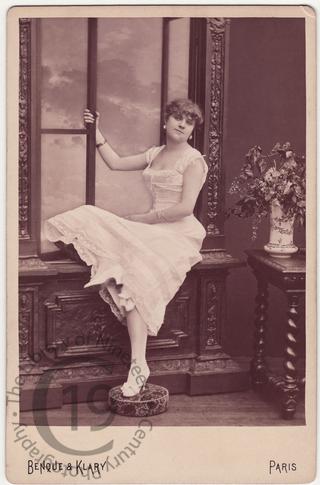
Alice Marot
A cabinet card portrait of a poule de luxe identified verso as Mlle Marot.
Alice Marot appears in The Pretty Women of Paris, an anonymous guide to the city’s prostitutes and courtesans, privately printed in 1883, with the subtitle ‘Their Names and Addresses, Qualities and Faults, being a Complete Directory or Guide to Pleasure for Visitors to the Gay City.’
According to this fascinating directory, those wishing to avail themselves of Mlle Marot’s services could find her at 4, rue de Marignan. In the author’s opinion, ‘This sprightly, fair, little whore has been very lucky. After a more than usually chequered career upon the boards of provincial theatres, she came to Paris, and at the Palais Royal Théâtre enlarged the circle of her lovers. Her fellow-workers in the army of Cupid swore that she spoilt the trade, as she tumbled on her back at all hours of the day and night for any little bit of gold or silver that the good gentlemen crossed her hand with. But she had her mother to keep, and a blonde little rascal of a boy. The son and heir of the founder of the gambling halls of Monaco took her to live with him some two or three years ago, and the wily courtesan has succeeded in getting the upper hand of him. By the exercise of her nimble fingers and warm mouth she is drawing him daily of health, brains and money, putting by all she can for her old age. She is singularly ignorant, and her continual mistakes in conversation have given her a reputation worthy of Mrs Ramsbottom. She has a neat figure, is of medium height and dresses quietly and well. Her face is very pleasing, although there is a dangerous rapacious look in her deep-blue eyes. In early life she was married to a bricklayer, who still hangs after her, and she has to silence him by continual gifts of money. Latterly, her lover wished to buy her a ten-thousand-pound horse, and the husband’s power of attorney had to be bought for four hundred sovereigns. Her teeth are none of the whitest, and although she wants for nothing, friends from old theatre are always accommodated gratis, for the sake of old times.’
Photographed by Benque and Klary of 33, rue Boissy d’Anglas, Paris. According to Voignier’s Répertoire des photographes de France au dix-neuvième siècle, Wilhelm Benque and Charles Louis Klary (real name Graindepice) were in partnership at this address from 1879 to 1880, when the studio was taken over by Kneubuhler. However, it continued under the names of its founders until the business was acquired by Matuszewski around 1900.
Code: 123634




